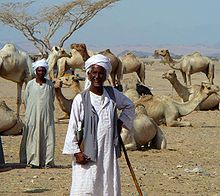Bedscha (ethnic group)
Bedscha or Beja are an ethnic group in northeast Africa with a partially nomadic way of life and are counted among the Bedouins .
Settlement area
Most of the Bedscha, around 2.2 million, live in East Sudan in the Jibal al-Bahr al-ahmar in the state of al-Bahr al-ahmar , and also in the states of Kassala , al-Qadarif and Nahr an-Nil . Other areas are located in the Gebel Elba National Park (in the Egyptian-Sudanese border area), in Ethiopia and Eritrea .
language

Their language is also called Bedscha or Bedawi.
Settlements
Economic reasons increasingly force people to settle in cities and to cultivate arable land. Bedjah who have become sedentary settle in unspecific houses made of bricks or clay. Nomadic bedscha traditionally live in unique barrel-shaped tents ( bidaigau ) that look like upturned boat hulls. A construction made of knots is covered with woven mats made of palm fibers ( takaib ). The floor remains free or is covered with bast mats. The tents are not fenced and usually set up at wide intervals.
Subsistence
The main food traditionally consisted of flour, lentils and dried jute leaves . Tea, coffee and sugar were also traded. Bread is baked either on a hot tray or in hot sand ( gurs ). Some tribes fish, for example in the Manazig area . Mussels are also eaten. Charcoal is used for cooking , especially acacia wood . In the past, hunting for gazelles ( Gazella dorcas ) also played an important role. Their pets include sand-colored medium-sized dogs, medium-sized light-colored donkeys, sheep, black goats, predominantly white, rarely fawn camels, and Asir-type chickens. The role of donkeys and camels is increasingly being taken over by jeeps. Sheep wool, goat and camel hair is spun and woven into mats and carpets. Goats and camels are also milked, and the milk is processed into yoghurt and cheese. Goats, camels and gazelles also provide hides for leather that is tanned with acacia fruits ( Acacia nilotica ). The camel saddles and sacks for storing food, clothing and valuables are also made of leather. Tending the sheep and goats as well as spinning and weaving is the job of the women, while the men are responsible for collecting wood and cooking. Coffee is drunk from tiny cups with ginger, cardamom, cinnamon and lots of sugar. Wild plants are used to make salads and teas, especially mallow and flea herb (Pulicaria undulata) . Branches of the toothbrush tree ( Salvadora persica L. ) serve as a toothbrush. After rainfall, millet ( sorghum bicolor ) is sometimes grown, which is used as camel feed.
Tourism is now an important source of income, for example in Wadi Gemal . The main earnings, of course, remain with the tour operators.
religion
The Bedjah are Muslims today .
history
Possible ancestors of the Bedjas were the Blemmyes , who repeatedly invaded the province of Egypt in late antiquity . At least since the 3rd century BC. Until the Arab conquest they controlled the trade between the southern Red Sea and the Nile valley. The Bedjas converted to Christianity in the 6th century . This happened under the influence of the three Christian Nubian empires Nobatia , Makuria and Alodia and the Aksumite Empire , under whose rule they lived from the third to the 8th centuries. When Aksum lost his power, the Bedjas founded five kingdoms in what is now northern Eritrea and east-northeastern Sudan. They later adopted Islam and further spread to Sudan.
The Arab traveler and geographer al-Mas'udi reported the following about the Bedjah in the 10th century:
“[They] live between the Red Sea and the Nile, divided into several tribes and subordinate to several kings. There are gold and emerald mines in their country . On their noble camels, they constantly undertake raids into the land of the Nubians and take prisoners. The Nubians used to be superior to the Bedjas until Islam prevailed among the latter and a number of Muslims settled near the gold mine [...]. Arabs from the Rabi'a Ibn Nizar tribal association also migrated to the same areas. They became very powerful there and married the Bedjas, who also grew in strength as a result. "
Sub-tribes
- Ababde between Al-Qusair and Ash-Shalatin
- Beni Amer
- Bishop south of Asch-Schalatin
- Hadendoa
- Hedareb
See also
literature
- René TJ Chappers: Roman Foodprints at Berenike. Archaeobotanical evidence of subsistence and trade in the Eastern Desert of Egypt. Cotsen Institute of Archeology, Los Angeles CA 2006, ISBN 1-931745-27-7 ( Berenike reports , 6; Cotsen Institute of Archeology . 55).
Web links
- Abdel Salam Sidahmed: The Beja. Minority Rights Group, 1995 (sudanupdate.org)
- Rolf Herzog: Cultural continuity of the Bedja from ancient times to the present. (PDF; 1.65 MB) In: Egypt - Duration and Change: Symposium on the occasion of the 75th anniversary of the German Archaeological Institute in Cairo. von Zabern, Mainz 1985, pp. 161–172 (reprints from the Albert-Ludwigs-Universität Freiburg)
Individual evidence
- ↑ Bedawiyet. A language of Sudan . ethnologue
- ^ Bernhard Streck : Sudan. Stone graves and living cultures on the Nile. DuMont Cologne, 1982, p. 110; Rolf Herzog: Egyptians, Nubians and Bedja. In: Hermann Baumann (ed.): The peoples of Africa and their traditional cultures. Wiesbaden 1979. Part 2, p. 611. The latter online (PDF; 2.4 MB)
- ↑ Quoted from Gernot Rotter (ed.): Al-Mas'udi: Up to the limits of the earth. Excerpts from the "Book of Gold washes" . Tübingen / Basel 1978, ISBN 3-7711-0291-X (Library of Arabic Classics, Volume 3)


